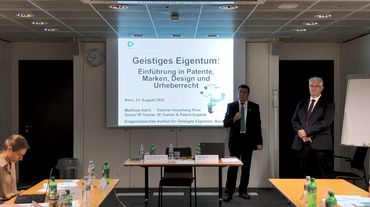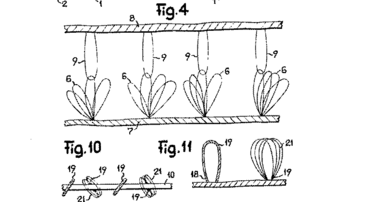Ever since his school-days, Nils Altrogge has been a very keen runner. After school, he obtained a Bachelor in Applied Sports Science at the University of Paderborn, followed a couple of years later by a Master in Sports Equipment Technology. He joined On in 2015 as one of its first innovation and development employees. Since then, he has been working with his team to develop new running shoes that are also sustainable. Although On’s core product is shoes, he sees On as a technology company.
For IP professionals
This is the portal for professionals working in the field of intellectual property. Here you'll find direct access to all necessary resources.
Quick links
Sports shoe inventor: “Nature is the best engineer”
When it comes to new ideas in running shoe technology, the sky’s the limit. The Swiss manufacturer On has even drawn inspiration from the woodpecker, says Nils Altrogge, Head of Technology Innovation. In our interview with him, he also told us how he keeps up his interest in inventing and what role protecting intellectual property plays for him.
![[Translate to English:]](/fileadmin/_processed_/5/e/csm_1_on_specht_iStock-691210384_a79bb282e5.jpg)
Nils Altrogge, you deal with sports shoes every day. How many pairs do you have in your wardrobe?
In a running shoe company, product testing is part and parcel of the innovation process. Only once I know what the product feels like can I develop it with my team. This means that my wardrobe is really full... I definitely have more shoes than my wife.
Do you go jogging?
Yes. Running is my big hobby. As well as using science-based innovation, our products must work for people. This means that it’s very important to have an understanding of comfort and the shoe as a whole. Running is a big part of that for me.

Copyright: On
Where do you get your inspiration for new running shoes?
One way is by looking exactly at what nature does. Nature is the best engineer and has developed solutions for various problems over millions of years.
For example?
The lotus effect is the classical way to change the surface tension for water resistance. We also drew inspiration for the cushioning system of our running shoes from the woodpecker. This hard-working bird hammers trees with its beak several thousand times per minute. But its brain shows no signs of damage. The reason is that there are many small bone cavities in its skull, one behind the other. Each of them cushions part of the blow. The woodpecker probably has the world’s best cushioning. That’s why we’ve lined up several different cavities in our soles – or clouds, as we call the hollow cushioning elements – to enhance the cushioning effect.
[Translate to English:]

[Translate to English:]
What else do you take a good look at?
The car industry, for example. Additionally, we look at areas that have nothing to do with consumer products. We get ideas for materials and construction methods from the building industry. In the area of sustainability, we look at areas in which things need to be dismantled again in order to separate and recycle materials.
What fascinates you about developing sports shoes?
Undoubtedly the idea of combining movement with technology. I’ve always been very keen on sport. I’m also interested in objects and tools that motivate people to move or make them faster or better. At On, I have the ideal opportunity to combine sport and technology.
On develops new sports shoe technologies. Does it patent its innovations?
Yes, because we invest a great deal of time and money in new ideas. Patents give us effective protection from third parties and allow us to make a return on our investment.
Is there such a thing as a holy grail in the sports shoe business?
Sustainability – a carbon-neutral shoe. In terms of sports performance, a shoe that has been scientifically proven to significantly reduce injuries. Finding this holy grail and thus motivating even more people to run or just get moving is very challenging.
You talked about sustainability. How green are On sports shoes?
It’s early days yet. The fashion industry has a huge impact on CO2 emissions. We aim to take responsibility in this area. When we plan to bring a product to market, we don’t just consider what it feels like or how it supports runners. We now also carry out a life cycle assessment (LCA) to determine how much CO2 is emitted in the production of the shoe. Based on this figure, we decide whether to market a product or not. We aim to use as many materials as possible that do not come from fossil fuels. Lastly, we weigh up whether the shoe has the optimum design for circular recycling.
How do you remain innovative? How do you manage to maintain your focus amid all these wonderful ideas?
We are in a position to promote a new approach to running shoes. That’s incredibly motivating. But it is indeed challenging to stay focused. Basically, we need to work in line with our strategies and constantly question which projects will actually benefit the company. The most critical projects are those that are really fascinating but that take up a lot of time, above all. We only pursue them for the very reason that they’re cool and fascinating.
What’s problematic about that?
These projects frequently can’t be marketed and they don’t contribute to our company vision. Together with other managers, I’m required to examine projects on an ongoing basis and check which ones will benefit us. This is only possible if we actively manage our portfolios. Focus is key. That’s why we set up ‘Kill your darling’ sessions. We review our projects every two months and stop any that are off track.
Note: This interview took place on 25 October during the SEF.Growth event in Bern (the IPI is one of the main partners). Nils Altrogge gave a talk about innovation that evening.



